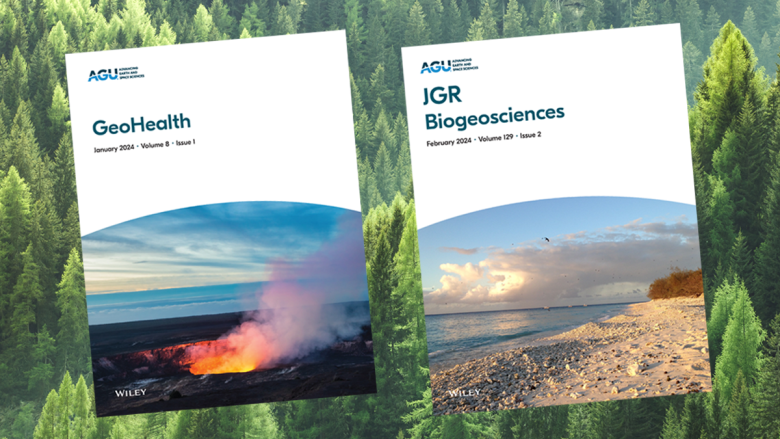
Editors’ Vox is a blog from AGU’s Publications Department.
Editorial boards are the lifeblood of scholarly journals. Editors and associate editors are key decision makers that guide AGU Publications in publishing high-quality and rigorously done geoscience. To meet these needs, ensuring diverse representation on our boards—encompassing gender, race, geography, and importantly, professional experience—has recently been identified as a priority for AGU Publications (Wooden and Ricci, 2023). It is important that editorial roles include early-career researchers because hearing their perspectives is beneficial for setting the standards for journal quality and for best editorial practices.
JGR: Biogeosciences and GeoHealth with support from AGU Publications and its Diversity Equity Inclusion and Accessibility subcommittee have made a commitment to support early-career researchers (Xenopoulos et al., 2023) who are interested in learning more about scientific publishing and journal editing.
Sustaining Journal Editing Through Mentoring and Training
Journal editing is one of many important tasks that researchers do without having received any formal training other than while on-the-job. The Early Career Editorial Fellow program will provide structured mentoring that teaches early career scientists editorial skills by providing them with an inside view on manuscript decision-making. This will be achieved by coupling early career editorial board members with more senior editors or associate editors to work collaboratively through the editorial workflow. Early career scientists will be mentored on the ethics of reviewing, and how key decisions are made at each stage from initial checking for scope, to reviewer selection, to final decision.
Mentoring is the Light that Shines on the Path to Success
Mentorship plays a pivotal role in shaping the success of early career scientists (Roche et al., 2019). Normally mentorship is achieved through graduate or post-graduate supervisory relationships. But these research supervisors do not always have the experience to guide their students on scholarly publishing or on the rapidly evolving publishing landscape. There is an opportunity for journal editors to provide this mentoring role and offer support, guidance, networking, and publication related advice to these emerging scientists. This relationship can be mutually beneficial. When working collaboratively, both mentors and mentees can bring fresh perspectives and innovative ideas and together solve the editorial problems of the day, whether it is related to ethics, bias, split recommendations, ghosting reviewers, finding suitable experts, or dealing with inappropriate reviewer tones.
The Future is Bright
Early career researchers have expressed “frustration that the editing, peer reviewing, and publishing ecosystem is built by people with whom they do not identify and by whom they are not represented” (O’Brian et al., 2019). They are also feeling the pressures of the publish-or-perish model, which they say disproportionally affect them, labeling this publishing model and the rapid rise of non-society edited publications as unethical (Receveur et al., 2024). But there is optimism. These emerging scientists are advocates for change. They promote open science. They are demanding systemic changes in the way we publish, by pledging to the San Francisco Declaration of Research Assessment (of which AGU is a signatory) as a means to de-emphasize harmful metrics like impact factors, asking for more inclusive citation practices and overall promoting an ethical publishing culture (Receveur et al., 2024). We are delighted to include this editorial experience in their professional journey, while they will undoubtedly simultaneously enrich ours. Today we are teeming with excitement to introduce you to this new talent below.
JGR: Biogeosciences Early Career Editorial Fellows
Hongyan Bao
Xiamen University, China
Specialty: oceanography; biogeochemistry; global change
Kyle Sampson Boodoo
University of Vienna, Austria
Specialty: limnology, biogeochemistry, ecohydrology
Kendalynn A. Morris
Pacific Northwest National Lab, USA
Specialty: microbial processes, plant-soil interactions, carbon and nitrogen cycling
Bailey A. Murphy
Oak Ridge National Laboratory, USA
Specialty: land-atmosphere interactions, ecosystem ecology, land surface modeling
Ceara J. Talbot
Carnegie Institution for Science, USA
Specialty: ecosystem ecology, biogeochemistry, ecohydrology
GeoHealth Early Career Editorial Fellows
Mohan Amarasiri
Tohoku University, Japan
Specialty: pathogens and water quality
Srinidhi Balasubramanian
Indian Institute of Technology Bombay, India
Specialty: air pollution, agriculture
Kyle D. Brumfield
University of Maryland, USA
Specialty: microbial ecology, molecular genetics, global infectious diseases
Fang Fang
University of Illinois, USA
Specialty: urban landscapes, human-environment interactions
Yun Hang
University of Texas, USA
Specialty: occupational health sciences, climate change and health
Muhammad Maqsud Hossain
North South University, Dhaka, Bangladesh
Specialty: pathogen detection and genomics
Yaoxian Huang
Wayne State University, USA
Specialty: atmospheric chemistry, chemical transport models
Phong Le
Oak Ridge National Laboratory, USA
Specialty: hydroclimatology, water resources, infectious diseases
Fangchao Liang
Southern University of Science and Technology, China
Specialty: air quality
Jennifer Stowell
Boston University, USA
Specialty: public health, wildfire smoke exposure, disaster planning
Christopher Tessum
University of Illinois, USA
Specialty: air pollution modeling, health impacts
Moiz Usmani
University of Florida, USA
Specialty: hydro-epidemiology, remote sensing
—Marguerite A. Xenopoulos (mxenopoulos@trentu.ca, 0000-0003-2307-948X), Trent University, Canada; and Thanh Huong Nguyen (thn@illinois.edu, 0000-0003-4032-9663), University of Illinois, USA
Citation: Xenopoulos, M. A., and T. H. Nguyen (2024), Lifting the veil of journal editing, Eos, 105, https://doi.org/10.1029/2024EO245023. Published on 13 August 2024.
This article does not represent the opinion of AGU, Eos, or any of its affiliates. It is solely the opinion of the author(s).
Text © 2024. The authors. CC BY-NC-ND 3.0Except where otherwise noted, images are subject to copyright. Any reuse without express permission from the copyright owner is prohibited.
Related
